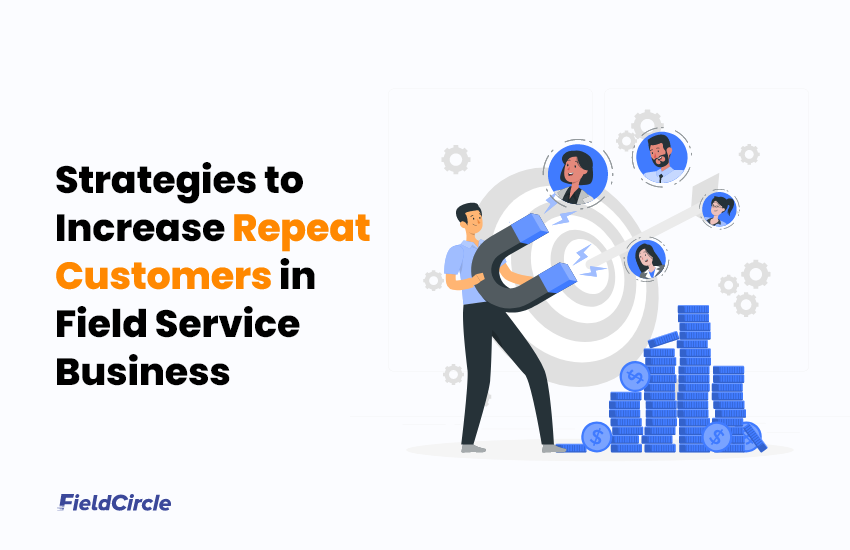How to Build a Competitive Advantage for Your Field Service Business

Have you ever wondered why some field service companies effortlessly outshine the competition?
This is because they have that extra something that sets them apart, that edge that keeps them ahead of the game and helps them stand out.
You might wonder, “What’s stopping my services from developing that competitive advantage? Or What are the competitive advantages for a service business?”
Let’s reflect on what might be holding you back. Is it a need for differentiation? You may be struggling to showcase your unique strengths and expertise.
Or it’s the fear of embracing innovation and adopting new technologies that could propel you forward.
Staying competitive in the industry is no small feat. You face many challenges, from rising customer expectations and increasing market saturation to technological advancements that reshape the landscape.
But it’s about finding that unique combination of strengths, strategies, and value propositions that makes a business the go-to choice for our customers. By consciously cultivating strengths and leveraging them effectively, you can position yourself as the preferred service provider in the minds of your clients.
We are here to help you develop your competitiveness in the field service industry. This blog comprehensively covers all dimensions, including the strategies, tools, and mindset required to thrive in the competitive landscape.
An Industry Outlook
The field service industry constantly evolves with technological advancements, changing customer expectations, and increasing competition. Recognizing and adapting these trends allows service providers to stay relevant, deliver exceptional customer experiences, and gain a competitive edge. Let’s understand these elements better.
Evolving Trends and Dynamics
The field service industry is not immune to change. It’s significantly experiencing new trends and dynamics that service providers need to be aware of to stay competitive. These are:
- AI-Enhanced Service: Utilizing artificial intelligence to automate processes, analyze data, and improve decision-making, leading to streamlined operations and resource allocation.
- Mixed Reality Maturity: Embrace immersive technologies like augmented reality (AR) and virtual reality (VR) to enhance troubleshooting, remote guidance, training, and collaboration.
- Direct-to-Home Service: Providing convenient and efficient service by bringing expertise directly to the customer’s doorstep.
- Enabling Mobility: Equipping technicians with mobile devices for real-time information access, effective communication, and prompt service.
- Predictive Maintenance: Leveraging data and analytics to identify potential issues before they become significant problems, minimizing downtime, and optimizing equipment performance.
Service providers must stay abreast of these trends and adapt these strategies for competitive advantage.
Key Players and Competitors
By understanding the market dynamics and the organizations that dominate it, businesses can gain valuable insights and identify areas for differentiation.
Some notable players include established companies like Salesforce, Verizon Connect, FieldNation, etc. These industry giants offer comprehensive service management solutions and have a strong presence in the market.
However, it is also essential to recognize smaller, niche players that specialize in specific verticals or offer unique features. By closely examining the competition and studying their strategies, service providers can adapt, innovate, and carve out their own competitive advantage in this sector.
Don’t Bury the Lead – Put Your Unique Value Proposition Front and Center
Journalists often repeat a golden rule: “Don’t bury the lead.” Instead, it’s all about putting the most essential stuff front and center.
But the same principle applies when it comes to selling services. So what truly sets successful service providers apart in the industry?
Their unique value proposition (UVP) and secret sauce make them stand out from the crowd. It’s that special something that connects with customers.
So here’s the key: aligning your UVP with your customers’ needs is essential. When you hit that sweet spot, and your UVP resonates with what they truly want, it creates a powerful connection.
So, let’s dig deep into the process and ensure your UVP reflects the value your customers seek.
Unveiling the Process: Discovering Your UVP
When it comes to identifying your company’s unique value proposition (UVP) in the Field Service business, it’s all about introspection and self-discovery. You must deeply dive into what distinguishes you from the competition and resonates with your customers. You can simplify this process by adopting simple steps into your competitive advantage strategy:
Step 1: Reflect on your strengths and expertise. What unique combination of products, services, or features do you offer? What problems do you solve better than anyone else in the field?
Step 2: Listen to your customers. Engage in meaningful conversations, conduct surveys, and analyze feedback. What do they value most about your services? What pain points do you alleviate for them?
Step 3: Analyze your competition. What are they offering? How can you differentiate yourself? Look for gaps in the market that you can fill with your distinct offerings.
Step 4: Craft a compelling brand story. Your UVP should be a part of your narrative, expressing the essence of who you are and what you bring to the table. Connect emotionally with your customers through your story.
Step 5: Test and refine. Implement your UVP and evaluate its effectiveness. Be open to making adjustments based on customer feedback and market dynamics.
Your UVP is not just a catchy tagline; it’s the core of your identity. Embrace what makes you unique and build your brand around it. Let customers see your story and feel the value you bring. You can create a relatable and reflective brand that stands out in your industry.
Leveraging Technology for Competitive Advantage
Technology is a catalyst, propelling companies toward success in a rapidly evolving landscape.
With the right tools and systems, technology does empower service providers to streamline operations, enhance efficiency, and deliver exceptional customer experiences. It’s not just about automating processes; it’s about leveraging technology to create a seamless and connected ecosystem that drives results. Here is how technological breakthroughs can enhance customer experience management.
Technology Innovations That Drive Exceptional Experiences
Technology innovations have revolutionized service providers’ operations, offering a competitive edge and exceptional customer experiences. Here are some examples of game-changing technologies and their impact:
Mobile Apps: Technicians can now access real-time information, manage schedules, and communicate with customers on the go. This streamlines processes, enhances efficiency, and boosts customer satisfaction.
Internet of Things (IoT): Remote monitoring and predictive maintenance empower service providers to address issues proactively, reducing downtime, increasing reliability, and improving service quality.
Field Service Tracking Software: It streamlines operations by automating tasks like scheduling, dispatching, and tracking. This leads to improved efficiency, reduced errors, and exceptional customer experiences.
Artificial Intelligence (AI): AI-powered chatbots and virtual assistants provide instant support, answering FAQs and resolving issues promptly. This improves responsiveness, reduces wait times, and enhances self-service options.
Augmented Reality (AR): AR technology offers real-time visual guidance, enhancing first-time fix rates, reducing training time, and improving accuracy in complex repairs. The use of augmented reality in field service is transforming how technicians interact with equipment and information on-site, enabling remote support and hands-free access to manuals or diagnostics in real time.
Data Analytics: Advanced analytics tools provide valuable insights, enabling data-driven decisions, personalized services, and optimized resource allocation.
ABB Group gained a competitive edge through IoT technology, offering real-time monitoring, predictive maintenance, and remote diagnostics for their devices. This has minimized downtime, reduced maintenance costs, and strengthened their position in the industry.
Run Your Business with a Modern Service Software
- Increase Profitability
- Reduce Costs
Schedule a Demo
Investing in Employee Training and Development
A skilled workforce consistently goes above and beyond, providing outstanding customer experiences and paying attention to every detail. As the CEO of FieldCircle, Yogesh Choudhary says, “Learning is not just about acquiring knowledge; it’s a transformative journey that leads to success. It’s not the destination of knowing more, but the destination of doing more.”
These skilled workers maximize productivity and possess problem-solving abilities that allow them to overcome challenges and improve your business practices.
In today’s rapidly changing environment, you must equip your employees with the necessary skills to adapt to new technologies. The World Economic Forum predicts that by 2025, half of all employees will need reskilling due to technological advancements.
If you invest in training your workforce now, you’ll be future-ready and ahead of the curve.
Approach To Innovative Training Methods:
Training helps professionals stay updated with the latest technologies, field service best practices and improves their productivity and the quality of their work. However, as per Lorman Education, it is worth noting that 33% of U.S. workers feel that their current company-provided training doesn’t meet their expectations.
Adopting innovative training methods can address these concerns and equip your employees with the necessary skills for success. So, let’s explore some effective training methods and programs for the professionals:
- Technology-based learning: Utilizes computerized training or e-learning for self-paced learning without in-person facilitators. It’s scalable and flexible, suitable for training many employees simultaneously.
- Simulators: Benefit industries with complex machinery, offering a safe and cost-effective training method. Reduces the risk of expensive mistakes while handling equipment.
- On-the-job training: Focuses on practical skills, enabling new hires to start working immediately. Employee shadowing enhances hands-on experience and provides valuable job insights.
- Coaching or mentoring: Implementing mentorship programs fosters employee growth and development. New employees receive guidance and support from experienced colleagues, creating a supportive environment.
- Instructor-led training: Traditional classroom-style training led by an instructor. Enables interaction, questions, and relationship-building among trainees. Scalability can be a challenge in larger classrooms.
It’s not just about teaching your team new skills; it’s about nurturing their growth and potential. When you have a well-trained team, the impact on customer satisfaction and company reputation is remarkable.
Firstly, your customers will experience exceptional service because your team knows how to handle their needs effectively.
Secondly, your company’s reputation will soar as word spreads about the exceptional quality of your service. A well-trained team reflects your commitment to excellence, and that’s what customers value the most.
Building Strong Customer Relationships
Building strong customer relationships is a critical factor to gain advantage and a vital aspect of the industry.
Research by Salesforce shows that 90% of customers consider the experience provided by a company to be as important as its products and services. This insight highlights the significance of prioritizing customer service as a competitive advantage strategy.
But here’s the surprising part of Gallup research: fully engaged customers, those who have a strong relationship with a company, bring a 23% premium in terms of share of wallet, profitability, revenue, and relationship growth.
These numbers indicate that investing in customer relationships pays off. So, as a provider, it’s time to shift your perspective and make customer service a growth engine, not just a cost center.
Strategies for building and maintaining strong customer relationships:
Now that we’ve set the stage and established the need for change. Let’s explore four powerful techniques that will transform how you engage with your customers.
Exceed Customer Service Expectations:
- Provide real-time support through live chat to deliver immediate sales and support assistance.
- Go the extra mile to make your customers feel special by sending thank-you notes, positively impacting your brand reputation, and increasing customer loyalty.
Provide Multi-Channel Communication:
- Choose the proper communication channels that drive conversion and provide a consistent experience.
- Focus on brand engagement by encouraging conversational interaction across all channels.
Appreciate Loyal Customers:
- Show appreciation to your loyal customers by offering incentives such as discounts, free products, and unique buying opportunities.
- Provide premium services like co-browsing, video chat, or chatbot support.
- Offer loyal customers exclusive benefits through early access programs.
Utilize Customer Relationship Management (CRM) Tools:
- Increase customer retention rates and streamline communication through faster communication tools.
Continuous Improvement and Innovation
There’s a common misconception in the industry that once you’ve established your business and found your groove, you can sit back and relax. Instead, companies need to surge ahead with continuous improvement and innovation if they want to stay relevant and successful.
Continuous improvement and innovation are not just buzzwords; they are the lifeblood of success.
Service providers can stay ahead of the game and thrive in an ever-changing landscape by constantly challenging the status quo, exploring new ideas, and adapting to evolving customer needs.
Four methods to foster a culture of continuous improvement:
Continuous improvement and innovation are about constantly seeking ways to improve processes, products, and services. Here are four methods to foster a culture of constant improvement in your business:
Embrace feedback: Encourage open communication within your team. Listen to their ideas, concerns, and suggestions.
Promote knowledge sharing: Encourage your team members to share their expertise and experiences. This creates a learning environment where everyone benefits from each other’s insights.
Set clear goals: It helps your team understand what they’re working towards. Goals provide direction and motivation. Encourage your team to set short-term and long-term goals aligning with your organization’s vision.
Encourage experimentation: Don’t be afraid to try new things! Encourage your team to experiment with innovative ideas and approaches. Foster an environment where calculated risks are welcomed and failures are seen as learning opportunities.
Conclusion
To beat the competition, you must delve deeper into understanding your customers. Put yourself in their shoes, empathize with their needs, and genuinely grasp their preferences. By doing so, you can tailor your approach to providing a superior experience that leaves them speechless.
So, how do you create a competitive advantage for your business? Target competitive advantage by going the extra mile, leveraging technology, and delivering an experience that leaves them speechless.
It not only sets you apart from rivals but also ensures long-term success. You can exceed customer expectations and outshine competitors by understanding your target audience, conducting market research, and tailoring your services.


